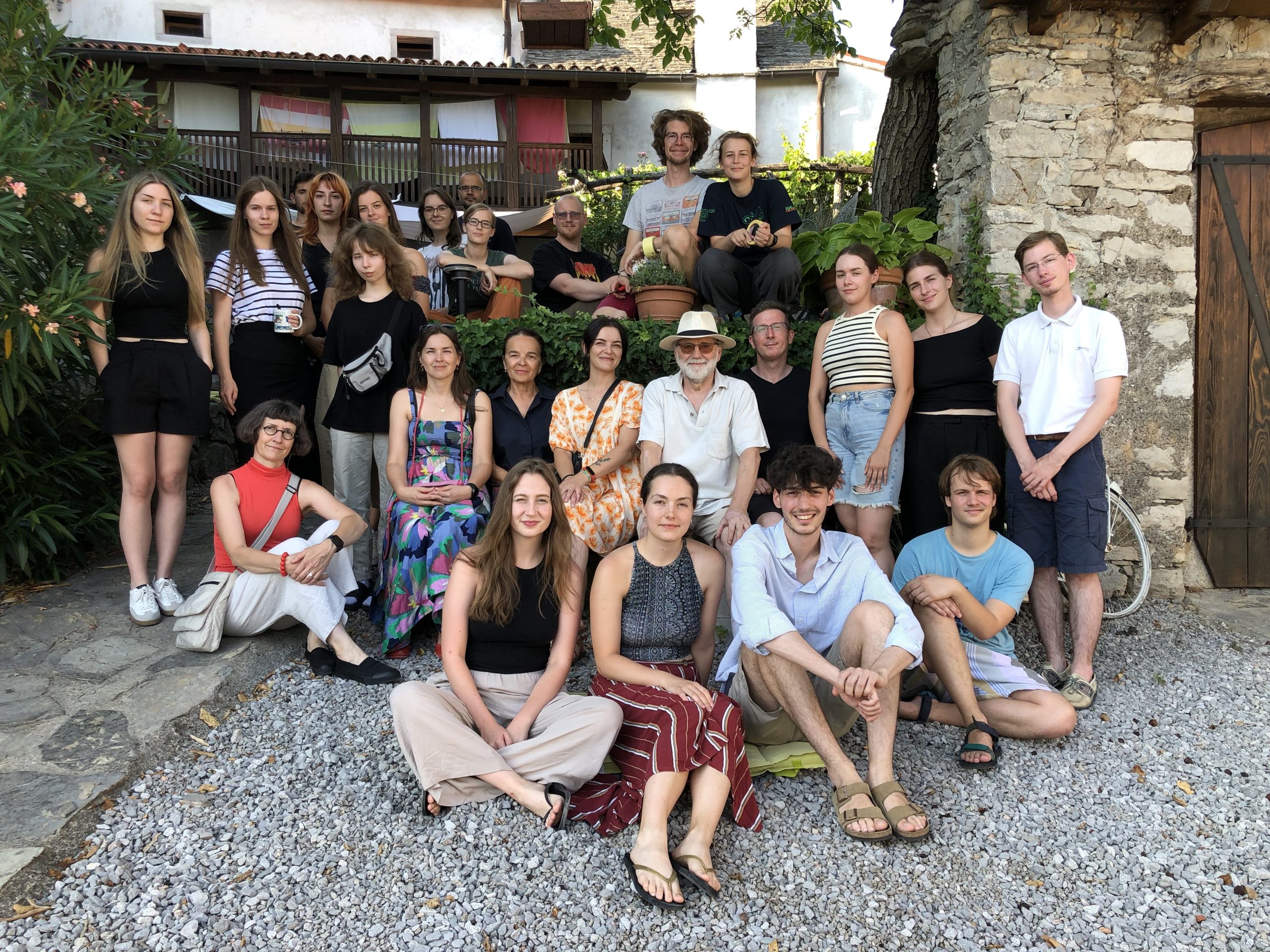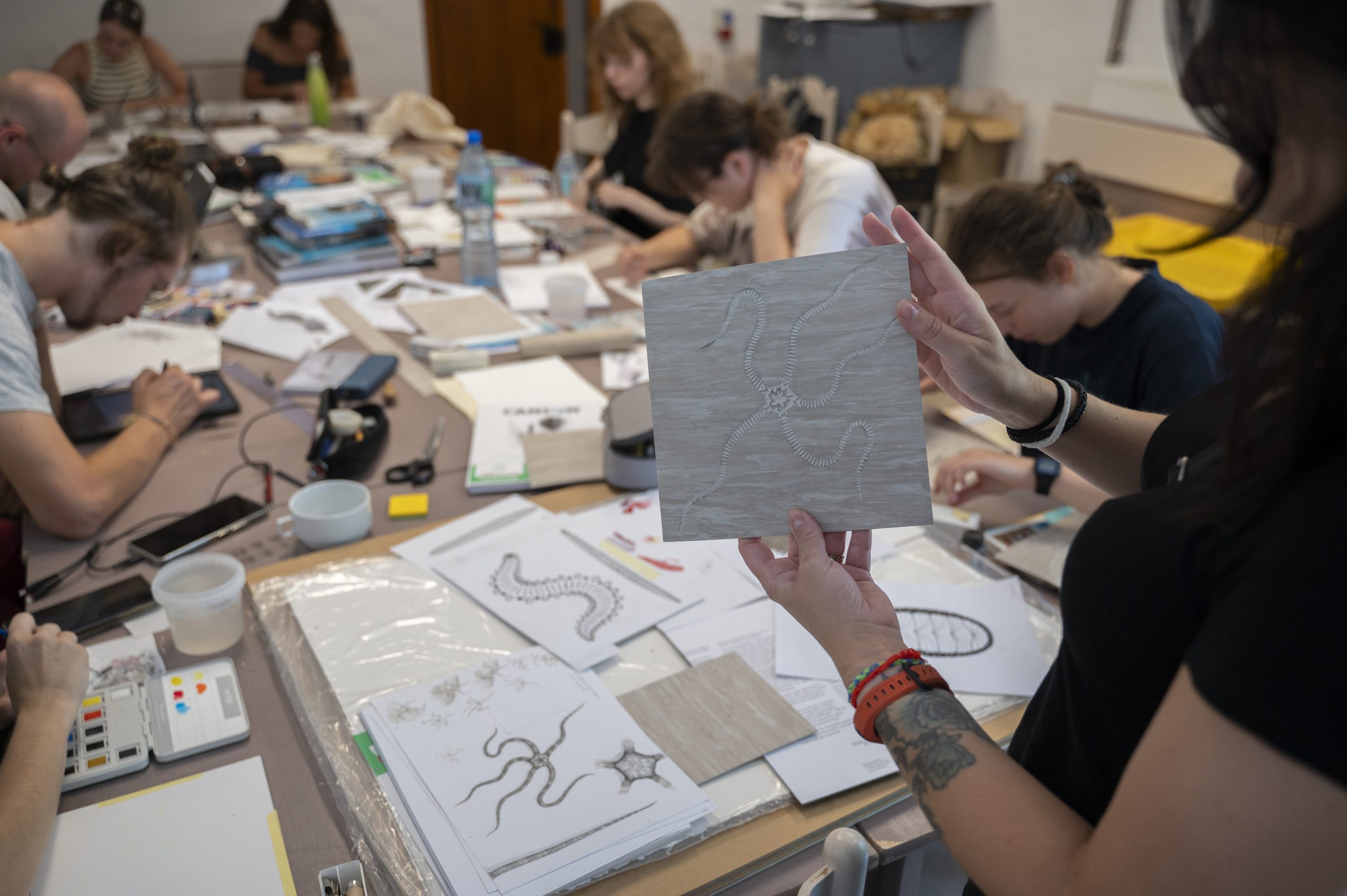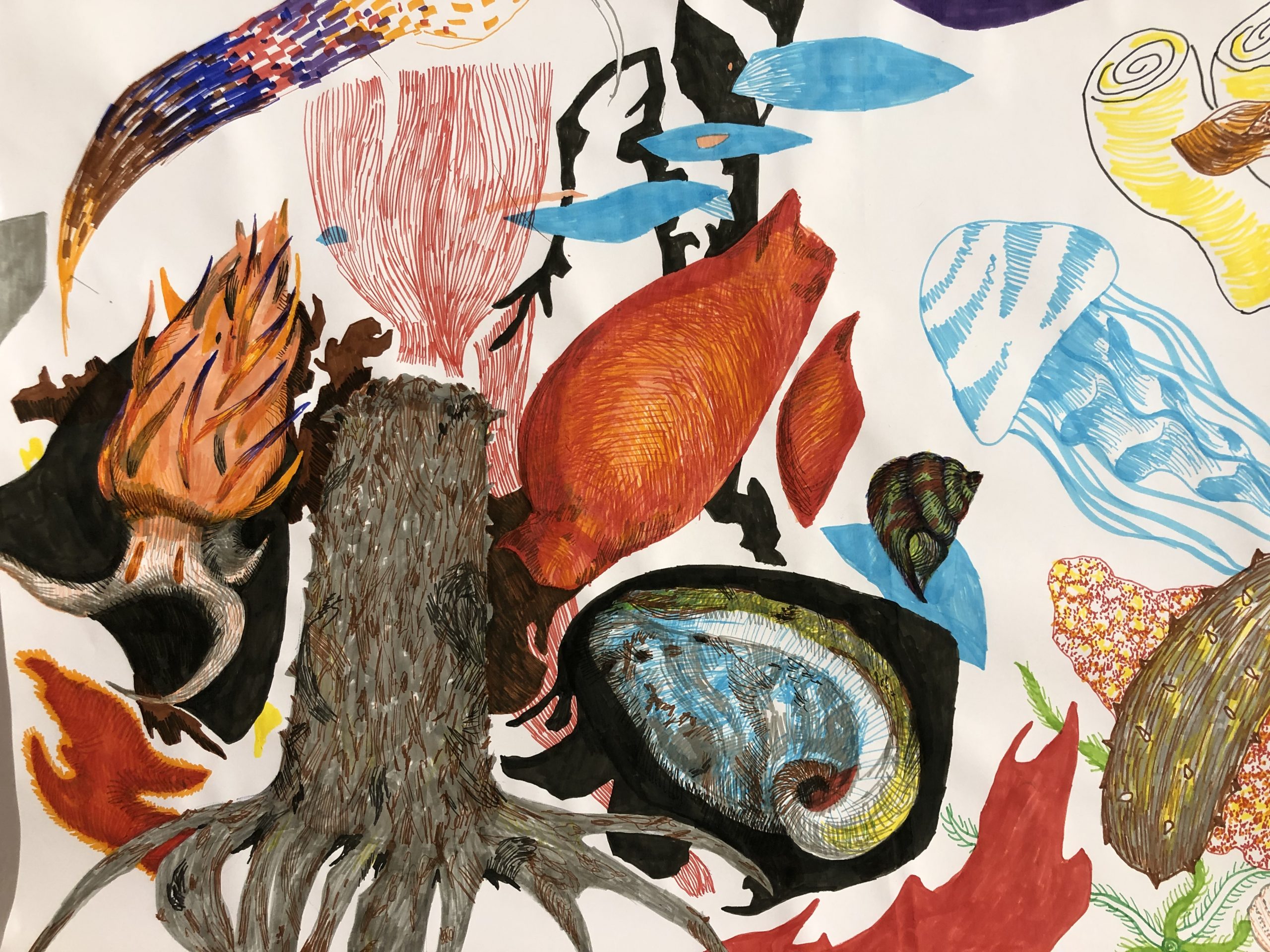Kaverljag: illustration for the blind and visually impaired
Since 1998, the Kaverljag Association and UL ALUO have collaborated on projects in the fields of environmental and social sustainability, often placing vulnerable social groups at the centre. Within these interdisciplinary and multicultural projects, two books for the blind and partially sighted were produced in the past: Dotakni se ptice (Touch the Bird) and Žuželke od blizu (Insects Up Close). This collaboration, however, came to a halt in 2012. Recognizing its many positive outcomes, UL ALUO saw an opportunity to revive this legacy in 2024, as it provided an ideal platform for connecting students of design, biology, pedagogy, and the arts. The initiative was linked to visual literacy (as part of the research programme P5_0452, Visual Literacy, co-financed by ARIS) and in 2024 continued with a focus on marine biology. Given that the Visual Literacy research programme is concerned with exploring the visual, it may at first glance seem paradoxical that the project focuses on people with various visual impairments, for whom the visual is virtually out of reach. Yet, this very contradiction became the starting point in our reasoning: in order to truly understand the visual, it is necessary to explore what lies beyond the visual. (Černe Oven, 2025)
The aim was to develop an empathetic and interdisciplinary approach to the design of tactile scientific illustrations, building partly on past experience while introducing new methodological and pedagogical approaches. We also consciously drew on practices employed by individual UL ALUO educators over the past decade: student-centred teaching, internationalization, multidisciplinary collaboration, and sustainability.
Phases
The project consisted of several phases that complemented one another.
Phase 1: Analysis of existing practices
Before the summer school, an interdisciplinary group of students conducted research into materials available for the blind and partially sighted. They found that, while there is a relatively wide range of picture books for early literacy, didactic scientific illustrations—especially in biology—are rare. Resources related to marine biology are particularly scarce, which is why the project focused on this area.
Phase 2: Kaverljag International Summer School: Marine Organisms for the Blind and Partially Sighted
Held in Pliskovica, on the Karst plateau, the school brought together 24 participants from five countries. The theoretical component included lectures by scientists, designers, artists, and specialist teachers of the visually impaired on inclusive design, the marine world, and sensory perception. A key emphasis was placed on developing empathy, notably through an experiential workshop simulating everyday challenges faced by blind people. Students also took part in excursions organized with partner institutions, after which they sketched and illustrated marine organisms, simplified them through linocut, and prepared graphic adaptations of scientific illustrations. This required balancing scientific accuracy, graphic clarity, and the adaptation of proportions of visual elements to Braille standards. Owing to the high cost of embossing, they also explored 3D printing as a more affordable option for users.
Phase 3: Continuation and Testing
After the international summer school, a core working group of students adapted the illustrations for an optimal tactile experience: they prepared vector files for 3D modelling and experimented with materials and printer nozzles. Through iteration and collaboration, they developed tactile illustrations accessible to the blind and partially sighted. The illustrations, together with accompanying materials (audio recordings, original scientific illustrations, descriptions of marine organisms, process documentation, etc.), were prepared for exhibitions. In cooperation with associations of the blind, partially sighted and deafblind, guided tours were organized to gather feedback and conduct testing.
Continuation
As illustrated didactic materials for the blind and partially sighted remain scarce, this project sought to expand the range of accessible resources for this vulnerable group. Alongside practical work, we developed theoretical methods and recommendations for creating tactile scientific illustrations using 3D printing, published in the scientific monograph Illustrating the Invisible: Design for an Inclusive Society (UL ALUO, 2025).
Building on improved prototypes, an open-access database of tactile scientific illustrations for the blind and partially sighted is now being established. With plans to expand the collection annually through integration into the curriculum, the experience will be passed on to new generations of students, thereby empowering young designers to act professionally and empathetically in the field of social design. The database and accompanying “print-on-demand” guidelines will support teachers, families, and specialist educators in teaching the blind and partially sighted.
The project’s outcomes thus benefit blind and partially sighted individuals, students, professional designers, and special-needs experts alike. All stakeholders can gain valuable insight into interdisciplinary approaches, while the initiative underscores the importance of inclusive design for the profession, its users, and society as a whole. At the same time, the project contributes to the discussion on visual literacy and inclusive design through collaboration between art and science, fostering the development of new projects that improve access to information and enable equal participation in society.
Results
- What I Look at and What I See: Marine organisms for people with visual impairments, exhibition, Center of Illustration Gallery, Ljubljana, 10 September–6 October 2024.
- Guided visits for institutions, schools, and groups during the exhibition.
- What I Look at and What I See: Marine organisms for people with visual impairments, Insula Gallery, Izola, Slovenia, 10 October–6 November 2024.
- Černe Oven, Petra, Marija Nabernik. “Scientific Illustration for Blind and Visually Impaired – for a More Sustainable Society and What Design Can Do About It: A Case Study”, The Nineteenth International Conference on Design Principles and Practices, 25–27 February 2025, LASALLE College of the Arts Singapore, Singapore.
- Festival of Food for the Brain, exhibition, Kongresni trg, Ljubljana, 12–15 May 2025.
- Scientific monograph Illustrating the Invisible: Design for an Inclusive Society (UL ALUO, 2025), published in Slovenian and English. The volume highlights the importance of social inclusion and demonstrates how thoughtful design can enhance quality of life. In addition to practical aspects (such as process descriptions, analysis of outcomes, and examples of good practice), the monograph also provides theoretical analyses of scientific illustration and design for the blind and partially sighted, offering clear recommendations for further work in this field.
Project leads:
– Marija Nabernik Bratuš, Petra Černe Oven (Academy of Fine Arts and Design, University of Ljubljana, Ljubljana, Slovenia)
– Aleš Sedmak (Kaverljag Society, Šmarje, Slovenija)
Project partners:
– Academy of Fine Arts of Bari (Accademia di Belle Arti di Bari), Bari, Italy
– Moholy-Nagy University of Art and Design – MOME (Moholy-Nagy Művészeti Egyetem), Budapest, Hungary
– Faculty of Art, University of the National Education Commission (Wydział Sztuki,
Uniwersytet Komisji Edukacji Narodowej w Krakowie), Krakow, Poland
– Academy of Arts and Culture in Osijek (Akademija za umjetnost i kulturu u Osijeku), Osijek, Croatia
– Center of Illustration (Center ilustracije), Ljubljana, Slovenia
Participating institutions:
– Union of the Blind and Partially Sighted of Slovenia (UBPSS)
– National Institute of Biology (NIB)
– Marine Biology Station Piran, Slovenia
– Faculty of Education, University of Primorska (Pedagoška fakulteta, Univerza na Primorskem), Slovenia
– Koper Intermunicipal Association of the Blind and Partially Sighted (MDSSK)
Mentors:
– Assoc. Prof. Mag. Marija Nabernik Bratuš, Academy of Fine Arts, University of Ljubljana
– Prof. Dr. Petra Černe Oven, Academy of Fine Arts, University of Ljubljana
– Assoc. Prof. Mag. Zora Stančič, Academy of Fine Arts, University of Ljubljana
– Assoc. Prof. László Nagy, Moholy-Nagy University of Art and Design (MOME), Budapest
– Prof. Dr. Magdalena Żmijowska, Faculty of Art, University of the National Education Commission, Krakow
– Assoc. Prof. Art. Miran Blažek, Academy of Arts and Culture in Osijek
– Aleš Sedmak, academic painter, president of the Kaverljag Society
Guest lecturers:
– Prof. Dr. Lech Kolasiński, Faculty of Art, University of the National Education Commission, Krakow
– Mag. Tim Prezelj, Faculty of Education, University of Ljubljana
– Prof. Antonio Rollo, Academy of Fine Arts of Bari
– Dr. Claudio Batelli, Faculty of Education, University of Primorska, Education Institute of the Republic of Slovenia, Koper
– Dr. Mateja Maljevac, Faculty of Education, University of Primorska, Koper
Participants:
– Academy of Fine Arts and Design, University of Ljubljana: Matevž Bervar, Zoja Čepin, Damir Omić, Ana Turičnik
– Biotechnical Faculty, University of Ljubljana: Gaj Kušar, Leon Rojk Štupar
– Academy of Arts and Culture in Osijek: Leo Pavlović, Nataša Takač, Stella Perica, Katarina Kovčalija, Rea Čondrić, Petra Kordić
– Faculty of Art, University of the National Education Commission, Krakow: Julia Polak, Agnieszka Stec, Emilia Waśniowska
– Moholy-Nagy University of Art and Design, Budapest: Beatrix Zsiros, Patrik Pauer, Zia Gréta Pintér
Financing:
– Development Pillars for Funding “Student Projects for Sustainable Development: B.II.3” (Developing and Strengthening Cooperation in Transnational Interinstitutional Learning Communities) and “Promoting the Inclusion of NonTraditional/Privileged Groups in Higher Education (S.C.1.3)”.
– Research Programme P5-0452, Visual Literacy at the University of Ljubljana, Academy of Fine Arts and Design, co-funded by the Slovenian Research and Innovation Agency (ARIS).
– Some segments of the project were co-financed by the Arts Council of the University of Ljubljana.
– The project was supported by the Municipality of Koper.
– The project was awarded funding from the UL Social Sciences, Humanities and Arts Fund (UL SSHA Fund) in 2025.

Gallery:
























